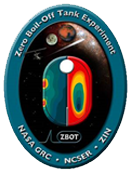ZBOT
Background
 Affordable and reliable cryogenic fluid storage for propellant or life support systems is integral to all phases of NASA’s projected space and planetary expeditions. One challenge facing engineers is self-pressurization. It can be caused by the cryogen vaporization that results from heat leaks into a tank from its surroundings and support structure. Engineers can relieve this self-pressurization through venting, but repeated venting of the vapor during long-duration on-orbit or on-surface storage will result in significant propellant loss, rendering the cost of long distance human space expeditions prohibitive[1].
Affordable and reliable cryogenic fluid storage for propellant or life support systems is integral to all phases of NASA’s projected space and planetary expeditions. One challenge facing engineers is self-pressurization. It can be caused by the cryogen vaporization that results from heat leaks into a tank from its surroundings and support structure. Engineers can relieve this self-pressurization through venting, but repeated venting of the vapor during long-duration on-orbit or on-surface storage will result in significant propellant loss, rendering the cost of long distance human space expeditions prohibitive[1].
This realization has provided a significant impetus for researchers to develop innovative pressure control designs—based on mixing the bulk tank fluid together with some form of active or passive cooling—to allow storage of cryogenic fluids with zero or reduced boiloff. Complicated dynamic interactions govern both tank pressurization and pressure control, including those between forced mixing, various gravity-dependent transport mechanisms in the vapor and liquid phases, and the condensation-evaporation process at the interface. Consequently, effective implementation and optimization of a dynamic pressure control system for space applications can be difficult to achieve, especially without prior relevant microgravity experimental data.
[1] J. Salzman, “Fluid management in space-based systems,” in Proceedings of the Engineering, Construction, and Operations in Space, 5th International Conference on Space, Vol. 1, 1996.
Research Overview
The Zero Boil-Off Tank (ZBOT) series of investigations involve small-scale fluid tank tests conducted in a microgravity environment to gather relevant data for validation of computational fluid dynamic (CFD) models and to study techniques for managing tank pressurization caused by the gradual warming of highly volatile liquids. The CFD models can be used to design future, larger storage tanks containing fluids such as cryogenic propellants. This research ultimately reduces the risk and costs of future space expeditions.
The ZBOT investigations are being carried out in three phases:
- ZBOT-1: studies self-pressurization and mixing destratification in microgravity
- ZBOT-NC: studies the effects of non-condensable gases on self-pressurization and mixing destratification in microgravity
- ZBOT-DP: studies droplet phase change in microgravity with and without non-condensable gases
Space Applications
Long-term storage of cryogenic fluids is necessary for spacecraft propulsion and life support. Scientific sensors aboard space telescopes and other space probes also require operation at cryogenic temperatures, but can only work as long as the cryogenic fluids last. The ZBOT investigations carry out small-scale microgravity tests to enable further research for lightweight, efficient and long-duration cryogenic storage in space.
Earth Applications
Cryogenic tanks require complicated storage and flow solutions for fluids that act as both liquid and gas, depending on their temperatures. The ZBOT investigations study the role of phase change physics and heat transport on the pressure control of these volatile fluids. Results from the investigations improve models used to design tanks for long-term cryogenic liquid storage, which are essential in biotechnology, medicine, industrial, and many other applications on Earth.
Gallery
Contacts
Principal Investigator: Dr. Mohammad Kassemi, NCSER/NASA Glenn Research Center
Co-Investigator: Dr. Manoochehr Koochesfahani, Michigan State University
Co-Investigator: Michael Meyer, NASA Glenn Research Center
Project Scientist: Dr. Howard Pearlman, NASA Glenn Research Center
Project Manager: Daniel Brown, NASA Glenn Research Center
Payload Developer: ZIN Technologies, Inc.
